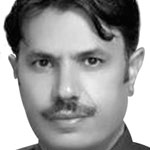The beauty of diversity
Zubair Torwali

Cultural and linguistic diversity has never been a favourite subject in our national discourse.
Instead of being proud of our beautiful linguistic diversity our policy and decision-makers have always been afraid of it. But the reality is that despite an ostrich strategy, events like the secession of former East Pakistan and national wounds related to that are haunting us and will continue to do so unless we ensure diversity in national policies.
Very few would know that over 65 different languages are spoken here along with the so-called ‘provincial languages’ – Punjabi, Pashto, Sindhi and Balochi. The policy of enforcing a single language by education and security policies in order to achieve an imagined national cohesion strikes down the very objectives for which it was created. This ‘one language-one religion-one nation’ policy establishes the hegemony of a single language; and consequently of an alien culture because language is the most effective driver of culture.
This also accelerates the ‘language and culture shift’ within the society and ends with more chaos and an unending identity crisis. The most detrimental is the national policies on education.
“Our children are ‘forced’ to learn Pashto at the early stages. We, the teachers, even can’t write or read it well”, a Pashto speaking teacher told during a survey called Annual Educational Status Report ‘ASER’. “You are not allowed to speak Khowar (Chitrali) inside the classroom because it is ‘forbidden’ here”. A Khowar speaking teacher in central Chitral was warning his Khowar speaking students.
“Out, out. He speaks Punjabi”, the principal of a private school in Lahore drove away a student whose father, a lover of his language, brought him to the school.
Looking superficially at the above observations one tends to assume that the ‘speakers of the concerned languages’ do not want their languages to be used in education or in the media. But one shouldn’t jump to conclusions.
When a particular language is given advantage over others the speakers of the less developed languages tend to look down upon their own languages and cultures and regard them as the barriers in their ‘development’. Both English and Urdu are regarded as languages of development. One is considered educated and influential if one speaks English well. On second place comes the person who speaks Urdu well. And if somebody speaks either English or Urdu in his own accent he is regarded less educated.
Pashto speakers, who cannot pronounce certain words of Urdu in a correct way, are usually made fun of in the media. Today almost all the comic text messages circulated via mobile phones are related to Pathans and Sikhs. This is the result of a particular kind of education we have been experiencing in Pakistan.
In order to cope with the hegemony of a single language the educational polices need to be revised and adapted to the requirements of linguistic diversity.
The 18 Amendment is a right step towards this goal. In the wake of the devolution of education to the provinces Khyber Pakhtunkhwa’s former government adopted Pashto as the medium of instruction for primary education. Furthermore it resolved to incorporate four other languages (Hinko, Khowar, Seraiki and Indus Kohistani) to be gradually incorporated in the education at the primary stages. Hopefully such initiatives for the remaining languages in the province will also be undertaken.
In addition to these policies extensive research is needed for the standardisation of the orthographies of these languages. Many of the hindrances in the way of reading and writing a language rest in the orthography or writing system of it.
Take Pashto; with its multiple varieties, it is written differently in Pakistan and Afghanistan. Variety is no threat to a language, rather it enriches it. Pashto needs a central standard form similar to that of BBC English.
Similarly community researchers in the ‘minority languages’ need to sit together when devising orthographies for their languages. For instance, in Khyber Pakhtunkhwa and Gilgit-Baltistan all the languages other than Hindko and Brushaski are Dardic of the Indo-Aryan branch of languages. Most of the sounds are identical in these languages but the researchers hadn’t realised this and have been writing the same sounds with different letters.
Language activists in these communities may know that they, more or less, share the same ancestor and culture. A standardisation in the orthographies with more commonalities will not only make their job easier but also integrate the speakers and enhance their political and social powers.
Urdu is imposed at the cost of others as it has always been deemed a tool to unnaturally homogenise the diverse cultural landscape of Pakistan. The recent resolution by the National Assembly Standing Committee for Information, Broadcasting and National Heritage to have a commission on the language issue in Pakistan, though, is a positive step but is in no way a solution to the need to preserve and promote linguistic diversity.
Instead of a commission the government needs to declare all the languages spoken in Pakistan as national languages and get research initiated on these languages and cultures.
The writer heads IBT, an organisation dealing with education and development in Swat. Email: ztorwali@gmail.com
From : The News April 07, 2014
![]()
![]()
![]()
![]()